I live in London and they are over 40,000 restaurants (including coffee shops) here. So ranking for your restaurant in this city is definitely highly competitive. If you are reading this, you probably own a restaurant and looking for SEO tips to improve your visibility on Google. So here’s my approach to SEO for restaurant websites.
So, what’s the objective of my Restaurant SEO guide?
- Improve your restaurant’s visibility on search engines such as Google, Bing etc.
- Increase the visibility of your restaurant’s local rankings on local packs/map listings, local directories etc.
- Convert website visits to customers by either driving footfall to the restaurant or by increasing the online orders placed.
- Increase brand awareness and engagement from customers.
Restaurant SEO Tips to Improve SEO for Restaurants
I’ll be covering the following steps to optimise your restaurant website;
- STEP 1: Boost Restaurant Local SEO Presence
- STEP 2: Have a keyword strategy for your restaurant type
- STEP 3: Know your competition
- STEP 4: Define your Content Strategy
- STEP 5: Apply On-Page SEO
- STEP 6: Technical SEO
- STEP 7: Off-Page Strategy
- STEP 8: Social Strategy
- STEP 9: Measurement & Reporting
STEP 1: Boost Restaurant Local SEO Presence
In this step, I’ll cover what is necessary to improve local SEO for restaurants. The objective here is to dominate local search queries.
It is quicker to establish a presence in your local area via local listings before jumping on to implementing an SEO strategy for your restaurant website.
Create listings for your restaurant on Google Business (Local Packs), Bing Places, FourSquare, Allmenus, Zomato, TripAdvisor and local directories such as MapQuest, Dex YP, Yelp, City Search, CitySquares etc. I would highly recommend at the very least claiming and optimising your listing on Google Business Profile (formerly GMB) as it is completely free and easy to use to manage your online presence across Google, including Search and Maps.

Having your presence online on the local pack (as shown above) has many benefits;
- The local pack is displayed right at the top on Google SERPs above organic results.
- Local pack results are optimised for voice search.
- Good for brand awareness as your business is shown along with ratings and reviews.
- Clicking on the result will expand to a map showing your business explanation.
Also when you perform a search for a branded restaurant name on Google, it generally comes up with a knowledge graph if you have claimed a Google Business profile. This knowledge graph gives quick info about the restaurant such as;
- Address
- Phone number
- Business hours
- Website URL
- Reviews
- Photos
- Restaurant Menu (or order delivery)
- Attributes. Talking of attributes, Google has introduced 3 new attributes to GMB profiles, which appear in Search, Knowledge graph (as shown below) and Maps given the current COVID-19 situation;
- “curbside pickup”
- “no contact delivery”
- “dine-in”

I won’t be covering local SEO tips in this post. But at the very minimum, you must ensure NAP (name, address, phone data ), business description and business categories are consistent across your websites and citations. This is critical to the success of local SEO. If you are not familiar with local SEO, I would recommend you check out the following video tutorial explanation to understand how to rank in Google Maps.
You can use third-party local management tools like Yext, Partoo, Moz Local or Uberall that can assist you in creating, claiming and adding local citations to your business information in search results. These platforms also make it easy to manage your reputation online via review management.
Ensure that your clients can effortlessly locate your address, opening hours and contact details by prominently displaying this information on your website’s footer.
Let’s now move on to the restaurant SEO strategy for the website in the following steps.
STEP 2: Have a keyword strategy for your restaurant type
How to find keywords for restaurants?: Before you begin keyword research, knowing your food establishment type would help generate targeted keyword terms. This will help you map out your target audience to figure out which keywords to go after. The objective of this step is to arrive at a list of high search volume keywords that matches search intent.
I have listed a few food establishment categories below;
| Alcohol | Falafel | Korean | Seafood |
| American | Fast Food | Lebanese | Singaporean |
| Asian | Fish | Malaysian | Smoothie |
| BBQ | Fish and chips | Mediterranean | Soup |
| Bento | French | Mezze | South American |
| Big flavours, small prices | Fried chicken | Middle Eastern | Souvlaki |
| Breakfast | Gelato | Milkshakes | Spicy |
| British | Greek | Noodles | Sri Lankan |
| Brunch | Grill | Paella | Steak |
| Burgers | Grocery | Pakistani | Street food |
| Burritos | Halal | Pancakes | Sushi |
| Café | Hawaiian | Pasta | Sweet treats |
| Caribbean | Healthy | Peri-peri | Tapas |
| Cheap Eats | Hot dog | Pho | Thai |
| Chicken | Ice cream | Pie | Toast |
| Chinese | Indian | Pizza | Turkish |
| Coffee | Italian | Poke | Vietnamese |
| Curry | Jamaican | Portuguese | Waffles |
| Dessert | Japanese | Ramen | Wine |
| Desserts and sweet dishes | Juices | Ribs | Wings |
| Dim Sum | Kebab | Salads | Wraps |
| Dumplings | European | Sandwiches |
Restaurant keywords can broadly fall under 4 categories;
- Generic keywords like restaurants, takeaways etc. Example: “Restaurants near me”.
- Location keywords like restaurants in [your city/area]. Example: “restaurants in central London”, “restaurants in Manchester” etc.
- Niche keywords like Indian restaurants, Thai restaurants, rooftop bars etc.
- Or a combination of these. Examples: “Indian restaurants in London”, “Thai takeaways in Manchester”, “Thai restaurants near me” etc.
Don’t go chasing after every generic keyword like restaurants, takeaways etc. Yes, they are important but require a lot of SEO effort. Start with the basics first. Target keywords specific to your food establishment type.
Start by typing restaurants on Google to see what comes in the list of auto suggestions in Google. Also, look at the related searches right at the bottom of the SERPs for keyword ideas. These are usually a list of highly searched broad and specific phrases.
Start your keyword research on Google with a generic term – say “restaurants”. Make a note of the Google auto-suggestions and related terms on a notepad file. Then enter location keywords into the tool – “restaurant + country/city/street” terms. Add these suggestions to Notepad as well. Lastly, enter niche food establishment type keywords and again export them to Excel.
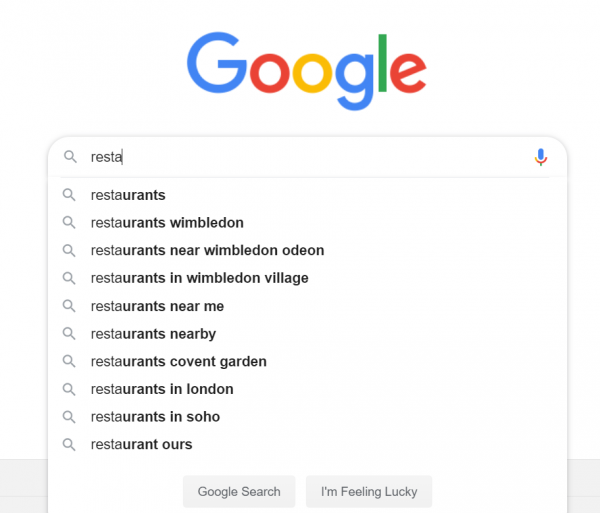 Restaurants Google Auto Suggestions
Restaurants Google Auto Suggestions
 Restaurants Google Related Search Terms
Restaurants Google Related Search Terms
Once you identify your niche food establishment type, the next step is to expand your keyword research. I would use a keyword research tool like Google Keyword Planner and a combination of either SEMRush / Ahrefs. See below, a few examples of screenshots for keyword research around Chinese restaurants;
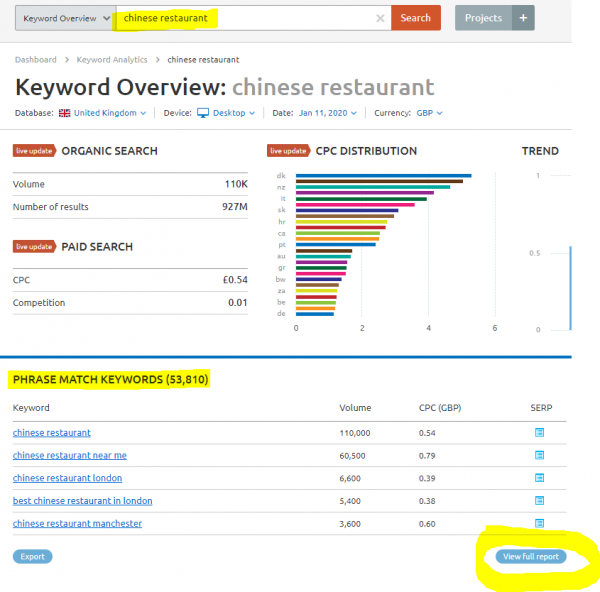 Restaurants Keyword Research using SEMRush
Restaurants Keyword Research using SEMRush
 Restaurants Keyword Research using Google Keyword Planner
Restaurants Keyword Research using Google Keyword Planner
Combine keywords from all the above steps, and de-dupe these to arrive at the final list of relevant terms for your business. Review the terms and remove irrelevant keywords or keywords with very low search volume.
So now you end up with a list of target terms to go after for optimisation and tracking.
STEP 3: Know your competition
Perform a few searches of your high-volume target keywords determined from the previous step on Google search to know your competition. You will be surprised that you are not just competing with other restaurants in your area but also competing with the likes of directory, review and social sites even for brand terms. You could also use tools like SEMRush to know your competition for your target terms or for your domain. I’ll show you how to use a combination of Google & SEMRush to get more keywords idea from your competitors.
Step 3a) Perform a search on Google for the term “Chinese restaurant London” and make a note of the first ranking URL from the SERP.
 Chinese Restaurant London Google SERP
Chinese Restaurant London Google SERP
Step 3b) Open SEMRush and paste the URL on the search bar to get a list of terms that the page is targeting. For this example, I’ll use the URL “https://www.timeout.com/london/restaurants/londons-best-chinese-restaurants” which is the first result on Google SERP from the previous step. SEMRush will then display a list of top organic keywords that the URL or domain ranks.
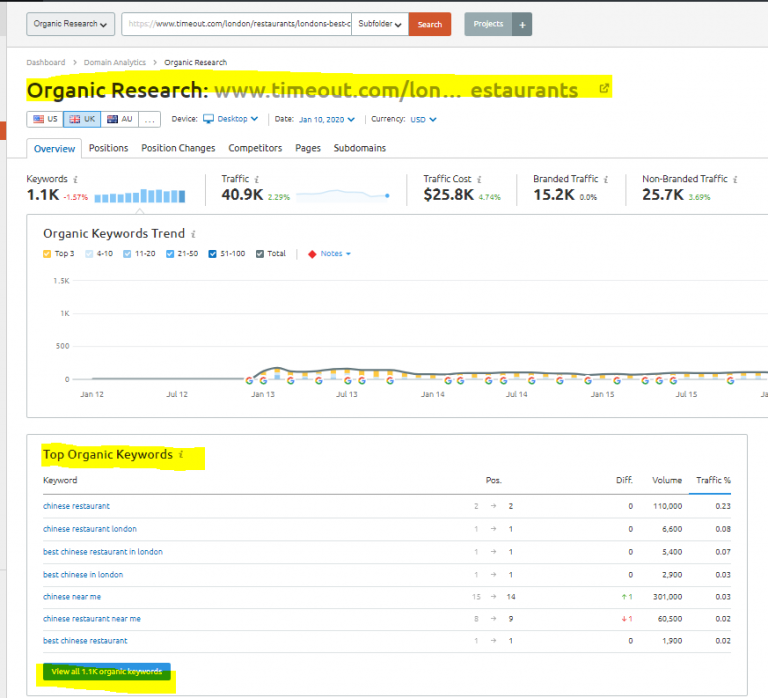 Chinese Restaurant London SEMRush
Chinese Restaurant London SEMRush
Perform a search on Google for the term “Chinese restaurant London” and make a note of the first ranking URL from the SERP.
Repeat this process for as many competitors competing for your target terms until you are satisfied. Once you are happy, combine these keywords with the list of keywords you achieved from the previous step.
STEP 4: Define your Content Strategy
The objective of this step is to create unique optimised content on your website. Make a list of the unique features of your restaurant first. This will get your thought process flowing for creating unique content using your target keywords. Some examples of unique features for your restaurant may include;
- Provides delivery (Even more specific – late-night delivery available).
- Has a kid’s menu?
- A family restaurant.
- In case you provide fast delivery, provide estimates based on the area of delivery.
- If you are one of the top-rated / featured restaurants in your area, highlight it to the user.
- Does it have a romantic ambience?
- Do you have vegetarian options or vegan options? Some would also be looking for gluten-free options.
- If your ingredients are sourced locally or organically mention it.
- Highlights your daily special dishes.
- A one-day exclusive holiday menu (e.g., a restaurant’s Valentine’s Day menu, Christmas menu etc.).
- Time-dependent pricing variations (discounted appetizers and cocktails during happy hour).
- Limited availability of items during specified hours, with the rest of the menu accessible throughout the day.
- If your restaurant takes online orders or accepts reservations, share the information in a prominent location.
- Showcase your restaurant awards & associations.
Having engaging content that is valuable to the customer is important. You want to keep the customer as well informed as possible for potential queries. Some customers may be interested in specific food items such as “full English breakfast”. So having a restaurant menu page displaying the items of the restaurant is vital. Ensure the menu is HTML and not an image or most commonly PDF.
You could have a dedicated blog section on your website and post about different happenings at your restaurant, promote new offers or post engaging material such as chef’s secret favourite recipes, diet articles, recipe articles, how you source ingredients, why you are the best in your city, new menu/bar item announcements etc. What a blog does for static websites such as restaurant websites is that it adds freshness in terms of unique content to the website translating to better rankings. A blog also gives you the ability to add long-form posts to target and rank for various related search terms. Remember to post your blog updates on Social media. Regularly updating your blog keeps your customers interested in the latest posts, news and events.

Develop unique content on every page;
- Create an editorial calendar for your blog and post regularly.
- Storytelling is important. If you have an interesting brand story about how you set up your restaurant, the culture or the founders, create a page to share details or include it on the bout us page to connect emotionally with your visitors.
- Keep your content fresh. In-Depth articles are better for SEO.
- Aim to rank in featured snippets in Google.
- Consider enabling the comments section on your blog to generate user-generated content. This is free valuable content for your site.
- Encourage customers to share reviews – You probably have a review management system on your site itself or rely on third-party review management systems like Trustpilot or GMB listing reviews. In either case, you must encourage customers to share reviews about your restaurant.
- Respond to positive reviews with a “thank you”. For negative reviews, try to understand the issue the customer experienced. Always respond to both positive and negative reviews which will help other potential customers. The higher the ratings, the more click-throughs to the site from SERPs.
STEP 5: Apply On-Page SEO
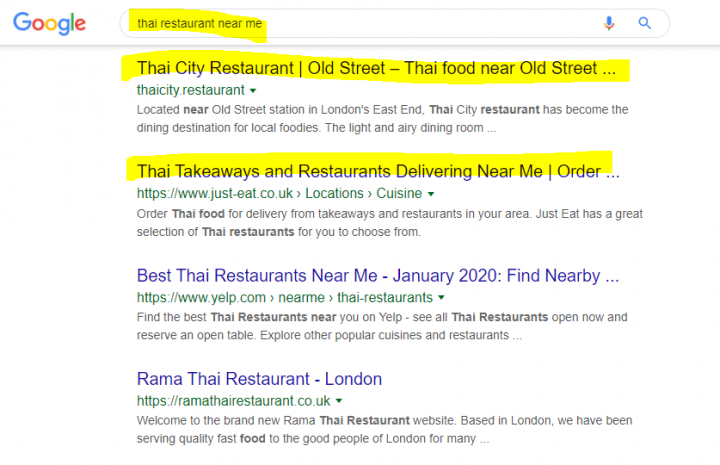 Thai restaurant near me Google SERP
Thai restaurant near me Google SERP
Optimise all the on-page aspects of your restaurant website. Without getting into the details of what each on-page optimization technique means and what the best practice is, please take a look at the below on-page SEO elements you need to optimise;
- Optimise Metadata – Title Tags & meta description.
- Keyword-specific page URL structure.
- Use keywords in your image file names and optimise your images using descriptive alt-tags for all images.
- Keyword-optimised Headings (H1s)
- Internal linking: Improve your internal linking structure by making sure all your website links are relevant and link to pages that have similar content or something your visitors might find useful.
STEP 6: Technical SEO
Again, I won’t be going into the details of what each technical SEO optimisation technique means and what the best practice is. Please take a look at the below technical SEO best practices to follow;
- Ensure the site is submitted to the Google search console (and Bing search console). Monitor search console errors regularly. The search console shows your site errors, and you can receive emails from Google Search if there are problems with your site.
- Ensure you have an automatically generated XML sitemap.
- Ensure you have an optimised Robot.txt
- Ensure your website is secure by implementing HTTPS.
- Ensure you implement Restaurant schema markup to provide additional context to search engines to help understand what page content is about. Structured data on search engines also attract more click-throughs when visible on search results. You may need developer support to implement the microdata for your restaurant pages or some CMSs even offer plugins to add schema mark-up easily. I also recommend you also look at the following link for more examples of Restaurants’ Schema and Structured Data Markup. Here’s a generator you could use to create your restaurant schema markup.
- You can also markup your restaurant menu with the restaurant menu schema structured data.
- Use the Google Structured Data Testing Tool to check if you have implemented the schema markup correctly. Through the use of structured data markup, you can have your review star ratings appear in SERPs and provide another compelling reason for a user to click on your site versus your competitor’s site.
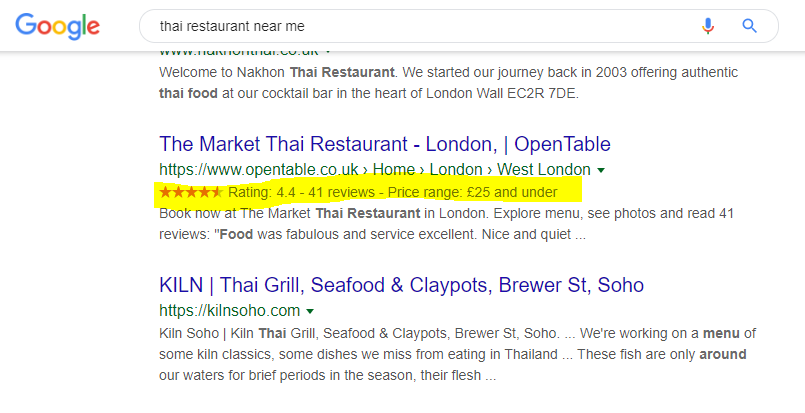
- Ensure the site is mobile-optimised. For the restaurant industry, mobile will account for a high percentage of visits as people are sometimes on the move when they would perform a search for a restaurant near them. Make sure your website is mobile-friendly. My recommendation is to have a responsive website that is mobile-first ready and provides a great mobile user experience and loads fast. You could also think of opting for Google AMP pages for your blog.
- Pay attention to page speed. A well-optimised site for page speed loads under 3 seconds. Use tools like Google page speed insights or webpagetest.org to determine your page speed.
- Scale your images to improve page speed.
- Compress your images so that it is served as the smallest file size possible, while still looking good. If you’re using a CMS like WordPress, there are plugins like WP Smush or ImageOptim to do this for you automatically.
- If you own a multi-location or a multi-chain restaurant, you need to have a strategy for this.
- If it’s a restaurant across different countries/languages, have separate localised websites targetting the respective country/language. Implement hreflang tags so Google doesn’t treat these as duplicates.
- If you own a multi-chain restaurant targetting a single location, have a separate restaurant location page for each area your restaurant is present in and give those pages a localised look to target local customers in that area. Make sure you provide enough cues and context to users and the search engines as to where your restaurant is located and what area /neighbourhood your restaurant serves.
- The site must be optimised for Voice search. Be aware of people using mobile. They would often use their voice to perform a search.
STEP 7: Off-Page Strategy
Building backlinks is important. Inbound link equity is critical for higher visibility. Try to generate backlinks from other businesses in your local area, review websites, restaurant online databases, local food blogs, neighbourhood associations, hotels & attractions websites etc.
List your restaurant on review websites or local food blogs and encourage feedback. Connect with other bloggers who own businesses in your area, so you can link to each other smartly via guest posts. This will give your restaurant business a great boost! You can also perform competitor backlink research to get linked from those sources as a quick win.
Reviews in search results boost click-through rates, attracting more potential patrons. Google considers reviews when ranking local search results, often displaying top-rated restaurants directly on the search results page. Diners most likely try a new restaurant based on positive online reviews, emphasising the importance of collecting feedback.
STEP 8: Social Strategy
Engage with customers in social media by committing to a social media strategy. Having a social presence encourages user-generated content and word-of-mouth referrals. People like sharing their experiences on Social and social ‘check-ins’. Facebook and Instagram are great places to start your social presence. Always respond to queries, complaints, testimonials and reviews whether they are positive or negative. Social media engagement can also help shape the content strategy of your website by seeing what people like or dislike. Having high engagement on your social channels makes your brand look legit and shows that people are interested in your brand.
Make your restaurant website more sharable by adding social media buttons on every page of your site. You could probably also go one step beyond by adding a Twitter feed to your sidebar.
Social media, email, and direct mail remain effective methods for enhancing brand awareness. While these strategies may not directly influence SEO, they contribute to generating referral traffic.
STEP 9: Measurement & Reporting
SEO is one part, but analysing your website traffic and optimising the site (such as making changes to site layout, navigation menu, call to action or U/X elements) to improve conversion based on user behaviour once a potential customer lands on your website is crucial as well. The objective of conversion optimization for restaurant websites is to make more money from your existing site visitors.
Make certain to have a clear call to action on each page. It should be straightforward for a visitor to reserve a spot, request more information, or view the menu for example.
Establish your key performance indicators for measurement. Use an analytics solution such as Google Analytics to measure visits, conversions, goals and revenue (if you sell online). Link Google Analytics and Google Search Console for more data.
Other useful KPIs could be tracking menu downloads, click-to-call conversions, tracking your top referring sites, newsletter signups, reservation booking goal conversions, tracking clicks on directions on local packs etc.
FURTHER READING OR VIDEOS WITH THE BEST SEO FOR RESTAURANTS TIPS
I hope this gives you a good starting point to improve your restaurant’s SEO visibility online. If you are looking for restaurant SEO services, Contact me today!

